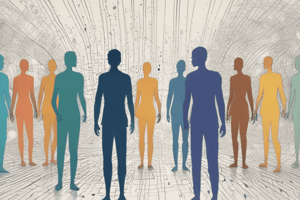Podcast
Questions and Answers
According to Nunan (2009), human interaction comprises a series of basic interactional patterns that are modified based on what?
According to Nunan (2009), human interaction comprises a series of basic interactional patterns that are modified based on what?
- The listener's attention span
- The setting of the conversation
- The speaker's mood
- The purpose of the interaction (correct)
In communication, the answering move is solely dependent on the knowledge of the topic being discussed.
In communication, the answering move is solely dependent on the knowledge of the topic being discussed.
False (B)
What is the significance of politeness and familiarity when addressing someone in a conversation, as illustrated by the interaction between Jane and Professor Smith?
What is the significance of politeness and familiarity when addressing someone in a conversation, as illustrated by the interaction between Jane and Professor Smith?
Expresses respect/builds rapport
The paradox in communication suggests that commencing a conversation is neither the ______ nor the end.
The paradox in communication suggests that commencing a conversation is neither the ______ nor the end.
What comprises the 'core' of communication, acting as its foundation?
What comprises the 'core' of communication, acting as its foundation?
The 'context' in communication primarily refers to the goal one intends to achieve through the interaction.
The 'context' in communication primarily refers to the goal one intends to achieve through the interaction.
In communication, what does 'missus' (from Latin 'mittere') directly translate to?
In communication, what does 'missus' (from Latin 'mittere') directly translate to?
To deviate or be unfaithful to an official plan or ideology is to be ______ message.
To deviate or be unfaithful to an official plan or ideology is to be ______ message.
Match the communication phrases with their meaning:
Match the communication phrases with their meaning:
In the context of sending effective messages, what does the suitability of the medium ensure?
In the context of sending effective messages, what does the suitability of the medium ensure?
Interpretation, as it relates to effective communication, is irrespective of religious, social, ethnic, and educational backgrounds.
Interpretation, as it relates to effective communication, is irrespective of religious, social, ethnic, and educational backgrounds.
In communication, what two elements does a speaker or writer present to effectively convey a message with a specific intention?
In communication, what two elements does a speaker or writer present to effectively convey a message with a specific intention?
The purpose of communication is the ______ the participants engage in communication, while the content is the goal.
The purpose of communication is the ______ the participants engage in communication, while the content is the goal.
Match the purpose of communication with its action:
Match the purpose of communication with its action:
Creating an 'impact' in communication requires not only effective speaking but also what?
Creating an 'impact' in communication requires not only effective speaking but also what?
The environment of communication only determines the form, not the content of the communication.
The environment of communication only determines the form, not the content of the communication.
Besides the environment, what else determines the appropriate language and utterances necessary for the social context?
Besides the environment, what else determines the appropriate language and utterances necessary for the social context?
Besides appropriateness and availability, one must consider the ______ of the channel to ensure the message reaches the target audience.
Besides appropriateness and availability, one must consider the ______ of the channel to ensure the message reaches the target audience.
What aspect of communication does 'tone' primarily identify?
What aspect of communication does 'tone' primarily identify?
Tone and diction of the speaker are synonymous.
Tone and diction of the speaker are synonymous.
For a foreigner who wishes to ask for direction, what must they have to reach their target and end goal?
For a foreigner who wishes to ask for direction, what must they have to reach their target and end goal?
Global communication in the global context identifies different communication needs and ______.
Global communication in the global context identifies different communication needs and ______.
What are the three essential types of materials needed when communicating in an international context?
What are the three essential types of materials needed when communicating in an international context?
Culture in communication refers only to the traditions and beliefs of a group of people.
Culture in communication refers only to the traditions and beliefs of a group of people.
What are the differences in one's culture that make people comparable to others whenever one wishes to connect with them?
What are the differences in one's culture that make people comparable to others whenever one wishes to connect with them?
Global communication involves one or a group of people or an organization from one or group anywhere in the world being sent by the intended recipient or target recipient from ______.
Global communication involves one or a group of people or an organization from one or group anywhere in the world being sent by the intended recipient or target recipient from ______.
Since we aim for global communication, what specific discipline should be known, as it studies communication affecting cultures?
Since we aim for global communication, what specific discipline should be known, as it studies communication affecting cultures?
Language in communication is only conveyed using verbal communication.
Language in communication is only conveyed using verbal communication.
What features convey meaning in speeches, consisting of vowels, consonants, words, pitch of voice, and loudness?
What features convey meaning in speeches, consisting of vowels, consonants, words, pitch of voice, and loudness?
Expressions are masculine cultures where members value male aggressiveness, strength, and material symbols of ______.
Expressions are masculine cultures where members value male aggressiveness, strength, and material symbols of ______.
What strategy are 'feminine cultures' moreso apt to do to resolve conflicts?
What strategy are 'feminine cultures' moreso apt to do to resolve conflicts?
Cancel culture is a culturally enriching concept that originated from educational institutions.
Cancel culture is a culturally enriching concept that originated from educational institutions.
According to the World Health Organization, what does ageism refer to?
According to the World Health Organization, what does ageism refer to?
Lacking an understanding of cultural differences means being culturally confused, and therefore, ______.
Lacking an understanding of cultural differences means being culturally confused, and therefore, ______.
What is the process of making choices that make one distinct from another instead of with the group?
What is the process of making choices that make one distinct from another instead of with the group?
Individualistic cultures are those in which group goals are stressed.
Individualistic cultures are those in which group goals are stressed.
Where are High-context systems tradition-bound, shaping the members' lifestyle?
Where are High-context systems tradition-bound, shaping the members' lifestyle?
In high-power distance cultures, superiors and ______ are likely to view each other differently.
In high-power distance cultures, superiors and ______ are likely to view each other differently.
Cultural silence is reflective of what?
Cultural silence is reflective of what?
In the SMCR model, only the sender matters.
In the SMCR model, only the sender matters.
Flashcards
Communication
Communication
A cyclical and iterative process that varies depending on our communication goals.
Basic Interactional Patterns
Basic Interactional Patterns
These include an opening, answering, and follow-up.
Paradox in Communication
Paradox in Communication
Launching a conversation neither starts nor ends it; it's a cycle.
Message Core Components
Message Core Components
Signup and view all the flashcards
Communication Definition
Communication Definition
Signup and view all the flashcards
Communication Steps
Communication Steps
Signup and view all the flashcards
Transcending Messages
Transcending Messages
Signup and view all the flashcards
Purposes of Communication
Purposes of Communication
Signup and view all the flashcards
Setting the Context in Communication
Setting the Context in Communication
Signup and view all the flashcards
Identifying the Target Audience
Identifying the Target Audience
Signup and view all the flashcards
Medium in Communication
Medium in Communication
Signup and view all the flashcards
Intention in Communication
Intention in Communication
Signup and view all the flashcards
Culture
Culture
Signup and view all the flashcards
Intercultural Communication
Intercultural Communication
Signup and view all the flashcards
Language
Language
Signup and view all the flashcards
Masculine Culture Values
Masculine Culture Values
Signup and view all the flashcards
Feminine Culture Values
Feminine Culture Values
Signup and view all the flashcards
Ageism
Ageism
Signup and view all the flashcards
Diversity
Diversity
Signup and view all the flashcards
Individuation
Individuation
Signup and view all the flashcards
Individualistic Cultures
Individualistic Cultures
Signup and view all the flashcards
Collectivistic Cultures
Collectivistic Cultures
Signup and view all the flashcards
High-Context Communication
High-Context Communication
Signup and view all the flashcards
Low-Context Communication
Low-Context Communication
Signup and view all the flashcards
High-Power Distance Cultures
High-Power Distance Cultures
Signup and view all the flashcards
Low-Power Distance Cultures
Low-Power Distance Cultures
Signup and view all the flashcards
Vertical Structure
Vertical Structure
Signup and view all the flashcards
Horizontal Structure
Horizontal Structure
Signup and view all the flashcards
Phonology
Phonology
Signup and view all the flashcards
Morphology
Morphology
Signup and view all the flashcards
Homonym
Homonym
Signup and view all the flashcards
Pragmatics
Pragmatics
Signup and view all the flashcards
Semantics
Semantics
Signup and view all the flashcards
Syntax
Syntax
Signup and view all the flashcards
Standard English
Standard English
Signup and view all the flashcards
Instrumental Language
Instrumental Language
Signup and view all the flashcards
Regulatory Language
Regulatory Language
Signup and view all the flashcards
Personal Language
Personal Language
Signup and view all the flashcards
Imaginary world
Imaginary world
Signup and view all the flashcards
Study Notes
Nature of Communication
- Communication constitutes a significant portion of daily human activities.
- Daily activities consist of exchanging information through predictable asking and answering actions.
- Communication is a cyclical and iterative process adapting to different purposes.
Nunan's Illustration of Human Interaction
- Nunan illustrates human interaction as a series of basic interactional patterns which is modified based on the purpose.
- The basic pattern consists of three key moves: opening move, answering move, and follow-up move, which creates an initial communication loop.
- Purpose modifications lead to additional loops or alterations of original loops that require familiarity with the topic, participants, context, and relationship-building.
- The answering move in an interaction changes based on the players' participation, knowledge, and familiarity.
- Follow-up moves are built on the participants' interest in building relationships.
Communication Paradox
- Launching communication involves introducing a conversation to achieve a task.
- Communication is a cyclical process that implies it's never-ending, and an iterative process that suggests the purpose is not finished but launched.
Effective Communication
- Effective communicators aim to achieve their objectives in every attempt, combining components necessary for success.
- The core of communication is the 'message', the 'heart' or central meaning.
- The message core needs a solid foundation: a clear purpose, credible content, intended context, and appropriate channel.
- Purpose is the reason for communication, content is the goal, context is the audience, and channel is the medium choice.
Origins of Message and Send
- The word message is derived from the Old French but has Latin origins of 'missus'.
- 'Send' has origins in Old English sendan, Germanic roots.
Usage of "Send a Message"
- Various phrases include: "send a message" (emphasize one's position), "take a message" (transcribe), "leave a message" (for unavailable person).
- Other phrases include, "be on message" (remain faithful), "stay on message" (be consistent), and "off message" (be unfaithful).
Integrity in Messaging
- Maintaining the integrity of intention is vital when sending messages.
- The selection of a medium is essential for effective communication.
- The elements making up an effective message follow principles to send and take the true message to the target audience.
Definition and Components of Communication
- Communication is defined as sharing information or messages with the target audience by using appropriate verbal, non-verbal, written, graphic, digital, or visual channels.
- It involves a five-step process: composing, encoding, transmitting, decoding, and giving feedback.
- Interpretation is integral, explaining the message's meaning in terms of religious, social, ethnic, and educational backgrounds.
Elements in Transcending Messages
- Writers or speakers use various elements to compose messages:
- A clear purpose
- A goal
- The purpose identifies the intention, target audience, tone, and diction to achieve the goal.
- Communication can aim to inform, educate, persuade, entertain, ask, receive, evaluate, or assess.
- It also identifies building relationships transact and interact and due to elements, the quality communication matters.
- The content guides the appropriate language to create impact.
- Persuasion in global communication requires appealing to others' perspectives, influenced by culture and education.
- Impact is achieved when a change in perspectives occurs.
Communication Settings
- Communication involves creating not only a setting but also a mood.
- Is context formal or informal, personal or organizational, that has departmental or global elements, to sets the tone.
- Diction is appropriate based on setting that determines necessary language.
Target Audience
- Identifies the target audience to uses the right language and gives sufficient information.
- Formality differs between academic and business settings and is based on the relationship of the target audience.
Medium
- Medium is the channel and needs appropriateness for its function to the target audience.
Tone
- Identifies formality and familiarity
- In academic and business settings, the tone is formal
Diction
- Diction relates to the register and tone of language.
- Tone identifies formality and familiarity in communication.
- Register and honorifics are informal communication elements.
- Diction describes appropriate language through answering questions like whether the language is formal, slang, or whether it is inclusive or exclusive.
- Intention and the goal must be clear and specific to provide foreigner precise instructions.
Global Communication
- Communication in the global context identifies different communication needs and competencies.
- Global citizens need people, and culture in international contexts.
Culture
- Culture signifies behaviors, traditions and beliefs of one group which distinguishes them from others.
- Culture show differences through gender, social class, and location..
Communication Method
- Communication is a repeatable and learnable step-by-step procedure.
- Aim for global communication to understand others as being multicultural through intercultural communication describing range of processes within social context.
Language
- That humans express themselves to is a tool is therefore a key tool to successful interaction using non-verbal and verbal techniques.
Communication Features
- Segmental and Suprasegmental features convey meanings. The features of pitch, sounds, and rhythm make up an quality of sound.
Gender in comms
- Meanings in text & speech show gender. expressions are mirrored based on culture.
- Masculine values are aggressiveness and strength, where cultures are dominant and use a win/lose strategy in conflicts.
- Feminine emphasizes relationships, tenderness in all genders, and quality of life with win/win goals.
Cancel culture affects perspectives with biases
- Language is a cultural entity that provides group identity, to promote unbiased and formal speech.
- Cancel culture means 'culturally blocked’ from a public platform.
Actions
- Ageism promotes (how we think, feel), and discrimination (act) towards others.
- Sexism leads to gender-bias toward women and girls.
Actions
- Promote communication between people representing international relations.
- Cultural ignorance is Lacking and is therefore, that affect people (Aristavate 2004)
Diversity
- Diversity valuing differentiation, vs individuation the making of choices that makes one distinct.
Cultures
- Individualic cultures stress individual goals vs. collective where group goals are greater.
Communication Styles
- Communication styles are either verbal in nature showing low context or are high context. Systems have tradition-bound rules that shape the behavior.
- Otherwise high context speakers act polite and are indirect and also indirectly on nonverbal communication styles.
The Low Context
- Context communication, Members of those cultures tend to: Exhibit a more direct communication style and gather background information when meeting for the first time.
Approaches to Language
Communication varies due to language to context High to low distance
- Power cultures are are different than what is deemed 'legitimate.'
- Also a vertical style of decisions in place.
Message structure
- Silos/structure is different in the workplace. Cultural language reflects a more superiority in others.
- By David Berio with the illustration of information transfers from the sender with equal listening capacity.
Historical
- The transmission and ritual model by Mclintock focus on ' linear process of interaction.
- The 'linear' and Carey's ritual' have different styles that show elements such as persuasion, and creating personal/branding images.
Purposes (compilation)
During composition, show intended purpose to:
-
- show Intention to context
-2) To medium Considering component effectiveness.
- Guiding components of any message process Thesis must have : main point(what we want/ are about and how to deliver
- Topic: and a position that engages audience from start through finish!
Persuasion tips
- 1 - Prove your aurgument/thesis. Strategies like comparison, and analysis.
- 2 - Discuss components of those, and how well they did throughout.
- and make inferences!
Studying That Suits You
Use AI to generate personalized quizzes and flashcards to suit your learning preferences.




